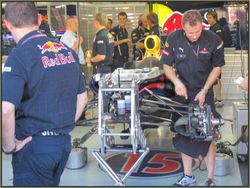New rules for smaller, more efficient engines mean that Formula One racing cars will get consume much less fuel, and be quieter. Could this lead to more efficient cars on our roads? Formula One designers and engineers are already putting together designs for more efficient cars in future seasons.FIA Rules Committee, Monaco, December 2010.
Formula One designers and engineers are already putting together designs for more efficient cars in future seasons.FIA Rules Committee, Monaco, December 2010.
The FIA's World Motor Sport Council (WMSC) has approved new regulations that will bring an environmental slant to Formula One racing from the year after next.
The 2013 season will see the end of the gas-guzzling 2.4 litre V8 engines currently used by F1 teams, and in will come 1.6 litre 4-cylinder turbocharged engines. “The WMSC approved the introduction of the new specification engine from 2013, underlining the FIA’s commitment to improving sustainability,” explained an FIA spokesperson.
The decision to implement the new more fuel efficient power units follows lengthy discussions between the FIA, engine manufacturers and racing teams. The move is a result of the new, more environmentally-aware approach from new FIA president Jean Todt – he has been reported as wanting the switch to 'greener' engines to make F1 a little less profligate with the Earth’s resources.
Todt's new approach has forced racing engine makers  F1 drivers will have to learn new driving styles to cope with the new engines' characteristics.to get the regulations sorted in time for the season after next, allowing a reasonable amount of time to get the completely new layouts sorted – along with new chassis plans to support the power plants.
F1 drivers will have to learn new driving styles to cope with the new engines' characteristics.to get the regulations sorted in time for the season after next, allowing a reasonable amount of time to get the completely new layouts sorted – along with new chassis plans to support the power plants.
The more environmentally-friendly engines are expected to deliver a 35% reduction in fuel consumption, with little in the way of performance change. The inclusion of improved KERS (Kinetic Energy Recovery System) units on the cars will also help ensure optimal energy management. The use of KERS – which uses the energy developed during braking to store power for use when the driver presses a button - on the last season’s cars has been optional, but this is likely to become a standard feature in future.
David Tucker, a spokesman from sports agency and sponsor experts KTB, interviewed for Brand Republic said the rule change should allow F1 to appeal to a wider potential sponsor audience, bearing in mind the brand impact of green issues on overall corporate social responsibility.
“Despite gradual changes to (motor) sport, some still perceive it to be wasteful and not sustainable,” he noted. “If brands are working hard to become more environmentally responsible, how can they become involved in the sport?” Teams are already discussing the changes to strategy and preparation they will have to makeTucker said that in his opinion this was a good commercial, as well as ethical and environmentally worthwhile move for F1.
Teams are already discussing the changes to strategy and preparation they will have to makeTucker said that in his opinion this was a good commercial, as well as ethical and environmentally worthwhile move for F1.
F1 engine maker Cosworth commented that the new regulations would probably save about 90 litres of fuel for every car in every race - and when the practice and development distances are also taken into account, that should see a considerable saving, the comapny noted.
Additional environmental impact reduction will come in the form of a cut in rev limits from the current 18,000 rpm to a maximum of 12,000 rpm. That should help on the earplug front too.
Photos by Jeremy Torr